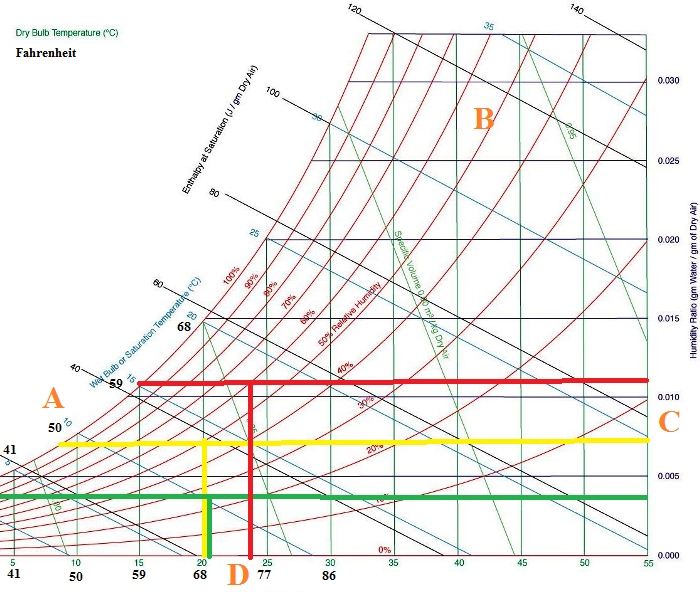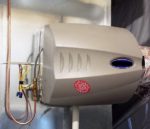 It’s that time of year again when the air is drier which can lead frizzy hair, static shock &/or for those in older homes, the doors to finally shut properly. It is also cold & flu season with many doctors recommending humidifiers be run at night for kids who get sick. For many the questions become; why do I need one / do I need one, what type, just at night or is all day better, just until they get better &/or how often should I run it? For others thinking of getting their Furnaces or AC units replaced you might be wondering, should I get one installed with the unit & what should I set it at if I do? Does it matter if I have a newer house, or an older one?
It’s that time of year again when the air is drier which can lead frizzy hair, static shock &/or for those in older homes, the doors to finally shut properly. It is also cold & flu season with many doctors recommending humidifiers be run at night for kids who get sick. For many the questions become; why do I need one / do I need one, what type, just at night or is all day better, just until they get better &/or how often should I run it? For others thinking of getting their Furnaces or AC units replaced you might be wondering, should I get one installed with the unit & what should I set it at if I do? Does it matter if I have a newer house, or an older one?
Why is the air so dry inside?
Quite simply the air is dry inside, because it is outside. For those with older homes that are “leaky” the issue stems from air infiltration. For those with newer tighter homes, it can be due to that or the ventilation requirements requiring one to pull in that cold, dry air. Ahh progress
Ok so it is a little dryer inside, do I need a humidifier?
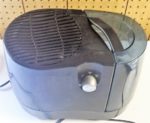 In short the answer is… it depends. What makes you think you need one? What is the humidity level at in the room or rooms in question? Just like many things, once you pinpoint the why’s, the what’s, & the when’s you can start really looking into the how can I solve the issue properly. Much more on this below
In short the answer is… it depends. What makes you think you need one? What is the humidity level at in the room or rooms in question? Just like many things, once you pinpoint the why’s, the what’s, & the when’s you can start really looking into the how can I solve the issue properly. Much more on this below
Why might I want or need a humidifier?
- Comfort is a top reason; while many of might have loved dragging our feet on the carpet & then shocking someone the fun quickly wears off. By raising the humidity level you can eliminate this & in some cases help tame the fly away hair. It also can help one feel warmer & possibly save some money on the heating bill (though you still have to pay for the humidifier running)
- Feeling better is another top reason; from sore / scratchy throat, to sinus passages that get dried out which can include nosebleeds most of this can be attributed to air that is to dry. Most doctors prescribe it to help with congestion as it helps keep the passages moist allowing for faster healing.
- Your body craves moisture; dry skin, cracked lips are signs that your body needs more.
- Medical; Asthma or other respiratory conditions might call out for it (but not too much & maybe not all).
- Your home & belongings; remember the joys of living in an older house (or visiting your grandparents) where the doors wouldn’t really shut in the summer & then all of a sudden they closed oh so easy during the winter or you could see cracks of light around a closed one… Well that effect is caused by moisture in the air & while most older homes are designed to handle that many newer ones (or wood furniture) don’t like swings like that. The more consistent the humidity and temperatures are, the better. Got some fine art, wines, or musical instruments, well you want to be careful of the moisture levels not only during the winter but summer months.
- Reduce risk of infections; I am sliding this one in but saying it with a grain of salt as many purports that viruses and bacteria can’t travel as well in moist air. I think much has to do with sinuses etc… not being dried out cutting down on coughs, minimizing sneezes & allowing ones membranes & systems to work better thus combating/blocking what gets breathed in.
Why might I not want a humidifier?
The list above sounds great & shoot if you visit a manufacturers site, they will probably make it sound even better. But as many know, to much of a good thing, isn’t good.
- Increased risk of infections / illness; legionella outbreak in a hospital – check caused by a humidifier. This & many other organisms just love standing water found in many humidifiers & filters. Shoot there is even a thing called humidifier fever out there. Yes this can be reduced / chances almost eliminated but that brings us to…
- More care & maintenance; you have to check with the manufacturer but many call for periodic cleanings (some every 3 days while others are monthly), replacing filters (which easily start at $10 a pop for small ones
- Introducing more chemicals into air; the chemicals used to clean the humidifier will get into the air &/or you might even add a special product to help “inhibit the growth of odor causing bacteria, control mineral & lime scale build-up”
- Cost; Not only do you have the electric use, but for many buying distilled water to use (or do more cleaning especially if you have hard or even soft water), filters &/or chemicals
- White dust; this is mainly a hard water issue but can be caused by any water with minerals in it that is aerosolized. For most it is just an annoyance but if you have asthma or other respiratory issue it can make it worse (if this is an issue look for a cool wicking type).
- Damage to house, furnishings, etc…; rotted windows, mold on the ceiling & walls… FAQ: Why are my windows / walls wet or have ice on them?
How does a humidifier work?
No matter what version you have, they essentially take water, turn it into moisture/vapor form which is then introduced into the air. There are two main variants – a cool mist & warm/steam mist.
- The warm / steam versions essentially heat the water up to produce vapor or steam. These can be great for wintertime use as the moisture coming out is warm/hot, not room temperature or less which can actually make it cooler. The downside is these units have big issues with minerals in the water which can not only release them but also clog or reduce the effectiveness of the unit over time. The other drawback is this is not a good “year round” solution as it can make your AC run more.
- There are two general types of cool mist systems which uses room/tap temperature water – evaporative & ultrasonic. The evaporative system works much like a “swamp” or evaporative cooler in which moisture is wicked into a pad with air being forced through it. The nice thing about this is that the higher the humidity level is in the house, the less moisture it will release. The second is ultrasonic where micro-fine water droplets are formed and forced into the air. The ultrasonic is one of the easiest to use but one of the biggest producers of white dust.
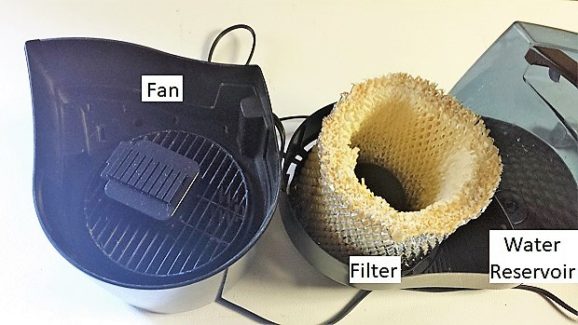
Whole House or Spot System?
Both have pros & cons but I would never install a whole house system unless it was a steam injected type (with a pre-mineral filter) where I have great filtration, and it was installed in a new properly designed & sized system which was balanced & proven to have essentially air-tight ducts.
- Whole House Standard (evaporative)
- Con – I cringe when I go into a new home to do a duct test as I can basically say you failed as they leak like a sieve. (Best one was only 10 cfm of leakage – most I say average anywhere from 20 to 50 cfm)
- Pro – Cheap to install
- Pro – generally minimal maintenance (some are monthly, while others are quarterly / seasonal)
- Con – moisture can go anywhere, rooms it isn’t needed, through leaky ducts to cold framing members, into the basement, etc… which doesn’t even include the water line running to it
- Con – you are introducing moisture into the ductwork which can have pollen, dust, etc… in it, essentially not only creating caked on layers but giving mold & mildew a chance to flourish when conditions are better
- Whole House Steam
- Con – Expensive
- Pro – seasonal maintenance generally only requirement especially with a mineral pre-filter
- See last two cons on Standard above though on a well designed & done system the issues will be
- Spot Systems
- Pro – can deliver moisture to where it is needed & when it is needed
- Pro – low upfront costs to buy
- Con – most maintenance required
- Con – requires one to fill tank preferably with distilled or demineralized water
What should I keep my humidity level at?
You know there is no “right” answer that will work for everyone. Certain organisms flourish at different temperature & humidity ranges. With that said we generally recommend 25% but are ok with it being between 20 – 40% range during the winter. (Based on lowest temperature)
But why do others say 40 – 60%?
Well that happens to be the summer range that was purported for many years which we will get to in another piece on Humidifiers. With that though I do not recommend going above 50% as that creates a breeding ground for mold, dust mites, bacteria, and other pests. (Based on lowest temperature)
Wait what is this “lowest” temperature?
That is important especially in the winter months as you do not want condensation forming on walls & windows. Remember also that humidity levels vary based on the temperature but the water vapor level or “grains” of water in the air is still the same. So lets say 100 grains at 75° = 50% humidity if the temperature drops to 65° you still have 100 grains of water in the air but you are now closer to 70% humidity.
Just how accurate is the humidity readings given by???
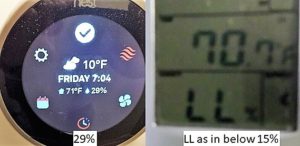 Shown is two different humidity readings – one doesn’t even read while the NEST is reading significantly higher. So which is accurate, probably neither but I haven’t replaced my hygrometer yet so I can’t say. Some factors that do impact readings (besides the quality of the instrument) is the location of it (mounting surface & cavity), air currents, sunlight, etc… That is one reason why we also shy away from whole house systems as you can be delivering to much to one location & not enough to where it is needed.
Shown is two different humidity readings – one doesn’t even read while the NEST is reading significantly higher. So which is accurate, probably neither but I haven’t replaced my hygrometer yet so I can’t say. Some factors that do impact readings (besides the quality of the instrument) is the location of it (mounting surface & cavity), air currents, sunlight, etc… That is one reason why we also shy away from whole house systems as you can be delivering to much to one location & not enough to where it is needed.
Are there other options to using a humidifier?
When I lived in Phoenix with the exception of maybe 5 to 6 days of static shock the humidity levels were fine, so do you really need one for those few days or is there something else you can do? Here are a few tricks that just might help;
- Don’t run your bathroom exhaust vent for showers during the winter – why not let the moisture help out? A few caveats – first you must leave the bathroom door open for the moist air to spread through the house. The next is if you do have major condensation issues (not just a fogged mirror) this is not a workable solution.
- Indoor plants – plants release moisture which can be good, but also bad. First don’t overdue it & for those of us in cold climates keep them away from exterior walls & windows but where they will still get light. Don’t also forget to water them & if they are looking a little limp maybe a light mist from a spray bottle will help
- The famous pot on the fireplace – yep a nice pot of water with maybe a stick of cinnamon slowly evaporating throughout the day…. Yes it does work wonders but it generally only helps out in the area around the fireplace. Yes you do have to make sure you keep it filled or risk some big issues.
- The famous pot on the stove or “mug warmers”/hot plate? Same as above but with a few more caveats…
- Gas stoves – this one will give you more bang for the buck as complete combustion results in a byproduct called moisture… the downside is incomplete combustion results in – carbon monoxide
- Electric stove, hot plate, mug warmer – yes it does work but there is one major caveat & that is what might be on the burner & the pan not including the differences in the metal that can create some bad off-gassing potentials.
What size humidifier do I need?
Sizing a humidifier depends mostly on the square footage of the area you want to humidify. Knowing the square footage can allow you to buy an appropriately sized one
Full time or just part time?
This one gets down to why you are using it – if it is to protect some art, etc… you hopefully have it tied into a good meter (see how accurate above) to automatically turn on & off as needed. Lets say it is for a sick kid or so you can sleep better, well having it on all day doesn’t make sense. In this case you might turn it on a few minutes to an hour before you or they go to bed & turn it off in the morning.
Is there a difference between older homes & newer homes?
While there are numerous differences when it comes to homes (even in the same subdivision), with humidifiers themselves & the advice above there isn’t. The biggest issue is older homes can handle humidity swings better while newer homes don’t & that can lead to issues that much faster with excessive humidity.
New houses & Ventilation System choices?
As mentioned at the start, a new house generally has much less air-leakage, but we are mandated to bring in so much “fresh” & yet dry air. This issue can sometimes be alleviated by choosing the proper ventilation system. In short, in super dry areas I would recommend an ERV which helps keep the moisture in, whereas in areas that are normally humid, I would go with an HRV (please note this applies mainly to summer humidity.) Exhaust /supply only or even air-cycler systems – well those won’t help the situation at all.
Is a humidifier only a winter time appliance?
No, you can use them during the summer though we would recommend sticking with a cool mist system. Please also note that in most climates it isn’t necessary & for the most part you probably need a dehumidifier. For those in dry climates (desert / mountain) it can be worthwhile though you may consider an evaporative / swamp cooler instead of using your AC. Just remember that above 45° dew point the coolers benefits go by the way side & won’t do as well (which by the same token applies to humidifiers)
Any additional tips?
- First & foremost – follow the manufacturers directions for cleaning & maintenance especially for whole house systems
- For whole house systems, make sure you turn down the humidity output based not only on need but outdoor temperature (many older dial ones actually have exterior temperatures listed on the dial for setting the level
- Don’t just blindly trust the thermostats humidity reading but use a hygrometer
- Clean your humidifier’s water tank / reservoir thoroughly using a soft-bristled brush and a mild cleanser. Rinse it thoroughly and wait for all components to dry before refilling it.
- For whole house systems, turn the water off when it won’t be used for an extended period of time, thoroughly cleaning & drying it out.
- Thoroughly dry & clean your spot system if it won’t be used for more than a day or two
- Use distilled or demineralized water.
- Replace your filters as recommended or sooner if you have pets or hard water
- Use a pre-filter to filter out minerals
